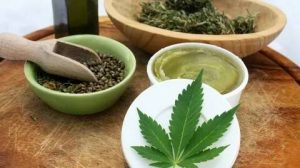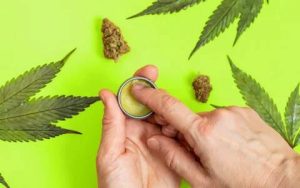
A weed topicals, also known as cannabis topical or marijuana topical, is a cannabis-infused product designed to be applied directly to the skin. Unlike other cannabis products that are ingested or inhaled, topicals are meant for external use and provide localized relief without inducing psychoactive effects. Here’s a guide to weed topicals:
How Weed Topicals Work:
Weed topicals work by interacting with the endocannabinoid system (ECS) in the skin. Here’s a basic guide to help you understand how weed topicals work:
- The Endocannabinoid System (ECS):
- The ECS is a complex network of receptors, enzymes, and endocannabinoids that exists in our bodies.
- It plays a role in regulating various physiological functions, including pain perception, inflammation, and immune response.
- Cannabinoids in Weed Topicals:
- Weed topicals are infused with cannabinoids, such as THC (tetrahydrocannabinol) and CBD (cannabidiol).
- THC is the psychoactive compound in cannabis, responsible for the “high” sensation.
- CBD is non-intoxicating and has potential therapeutic benefits, including anti-inflammatory and analgesic properties.
- Interaction with Skin:
- When a weed topical is applied to the skin, the cannabinoids interact with the cannabinoid receptors in the skin’s ECS.
- The two main types of receptors are CB1 and CB2 receptors. CB1 receptors are primarily found in the brain and nervous system, while CB2 receptors are predominantly located in immune cells and peripheral tissues, including the skin.
- When cannabinoids bind to these receptors, they can modulate various physiological processes, including pain signaling and inflammation.
- Localized Relief:
- Weed topicals provide localized relief, meaning their effects are primarily limited to the area where they are applied.
- They do not enter the bloodstream, so they do not produce the systemic effects associated with ingested or inhaled cannabis.
- Instead, the cannabinoids in the weed topicals penetrate the skin’s layers and interact with the nearby receptors, providing targeted relief to the applied area.
- Additional Ingredients:
- In addition to cannabinoids, weed topicals often contain other beneficial ingredients like essential oils, carrier oils, and herbal extracts.
- These ingredients may provide additional therapeutic benefits, such as moisturizing the skin, promoting relaxation, or enhancing the overall efficacy of the product.
Benefits of Weed Topicals:
Weed topicals offer several potential benefits due to the cannabinoids and other beneficial ingredients they contain. Here’s a guide to the benefits of weed topicals:
- Localized Pain Relief: Weed topicals can help alleviate localized pain and discomfort. The cannabinoids, such as THC and CBD, interact with the cannabinoid receptors in the skin, potentially reducing pain signals and inflammation in the applied area. They are commonly used to relieve muscle soreness, joint pain, arthritis, and other localized sources of discomfort.
- Anti-Inflammatory Properties: The cannabinoids in weed topicals have anti-inflammatory properties, which can help reduce inflammation in the skin and underlying tissues. This makes them useful for conditions such as dermatitis, eczema, psoriasis, and other inflammatory skin conditions.
- Skin Health and Repair: Many weed topicals contain ingredients that are beneficial for the skin. Essential oils, carrier oils, and herbal extracts in these topicals can provide moisturizing, nourishing, and soothing effects, promoting overall skin health. They may help improve skin texture, hydration, and appearance.
- Relaxation and Stress Relief: Some weed topicals are formulated with additional ingredients, such as essential oils or herbs, that have relaxing or calming properties. When applied to tense areas of the body, these topicals can promote relaxation and help reduce stress.
- Targeted Application: One of the key advantages of weed topicals is their ability to provide targeted relief to specific areas of the body. You can apply them directly to the affected area, allowing for localized effects without affecting the entire body.

Types of Weed Topicals:
There are several types of weed topicals available, each with its own unique characteristics and applications. Here’s a guide to the different types of weed topicals:
- Balms and Salves: Balms and salves are thick, often semi-solid formulations that are designed to be applied directly to the skin. They typically contain a combination of cannabinoids, such as THC or CBD, along with other beneficial ingredients like carrier oils, beeswax, and essential oils. Balms and salves are commonly used for localized pain relief and can provide long-lasting effects.
- Lotions and Creams: Lotions and creams have a lighter consistency compared to balms and salves. They are more liquid and easier to spread over larger areas of the skin. These topicals often contain a mix of cannabinoids, moisturizing agents, and other beneficial ingredients. Lotions and creams are suitable for general skin care and can be used for pain relief, inflammation reduction, and skin hydration.
- Oils: Cannabis-infused oils are versatile and can be used as massage oils or added to bathwater for a relaxing experience. These oils are typically a combination of carrier oils, such as coconut or jojoba oil, infused with cannabis extracts. They are easy to apply and can provide localized relief when massaged into the skin.
- Patches: Transdermal patches are designed to deliver cannabinoids through the skin and into the bloodstream. They often contain a higher concentration of THC or CBD and are formulated with permeation enhancers to facilitate absorption. Patches provide a controlled and extended release of cannabinoids, making them suitable for managing chronic pain or providing long-lasting relief.
- Sprays: Cannabis-infused sprays are a convenient option for applying weed topicals. They come in a spray bottle, allowing for easy and precise application. Sprays typically contain a mix of cannabinoids and other ingredients and can be used for pain relief, relaxation, or refreshing the skin.
- Bath Soaks: Cannabis-infused bath soaks are products that can be added to a bath for a soothing and relaxing experience. They often contain a blend of cannabis extracts, Epsom salts, essential oils, and other skin-nourishing ingredients. Bath soaks can help relieve muscle tension, promote relaxation, and provide overall stress relief.
How to Use Weed Topicals:
Using weed topicals is a straightforward process. Here’s a basic guide on how to use weed topicals effectively:
- Clean the Area: Before applying the weed topical, make sure the area of skin where you intend to use it is clean and free from any dirt or debris. You can wash the area with mild soap and water, then pat it dry.
- Test for Sensitivity: If you’re using a weed topical for the first time or trying a new product, it’s a good idea to perform a patch test. Apply a small amount of the topical to a small area of your skin and wait for 24 hours to see if any adverse reactions occur. If you experience any irritation, redness, or discomfort, discontinue use.
- Apply Generously: Take a sufficient amount of the weed topical and apply it directly to the desired area of the skin. Use your fingers or a clean applicator to gently massage the topical into the skin until it’s fully absorbed. Ensure that the product covers the entire area you want to target.
- Allow Absorption: After applying the weed topical, allow it to absorb into the skin without wiping it off. The absorption time can vary, but generally, you should wait at least 30 minutes to an hour before expecting the effects. It’s best to avoid touching or covering the area during this time.
- Adjust Dosage: Start with a low dosage and gradually increase if needed. Pay attention to the potency of the product and adjust the amount accordingly. Remember, everyone’s response to weed topicals can vary, so finding the right dosage may require some experimentation.
Dosage and Potency:
When it comes to dosage and potency of weed topicals, it’s important to understand that there isn’t a one-size-fits-all approach. The optimal dosage and potency can vary depending on factors such as individual sensitivity, desired effects, and the specific product being used. Here’s a guide to help you navigate dosage and potency considerations with weed topicals:
- Start with a Low Dosage: It’s always recommended to start with a low dosage, especially if you’re new to using weed topicals. Begin with a small amount and gradually increase as needed. This allows you to gauge your body’s response and find the optimal dosage for your desired effects.
- Read the Product Label: Pay attention to the product label for guidance on recommended dosages. The manufacturer may provide specific instructions on the amount of topical to use per application. Follow these instructions as a starting point and adjust as necessary based on your personal experience.
- Consider Potency: The potency of weed topicals can vary depending on the concentration of cannabinoids, such as THC or CBD, in the product. Some topicals may have a higher potency, while others may be more mild. Take note of the potency and choose a product that aligns with your desired effects and tolerance level.
- Individual Sensitivity: Each person’s sensitivity to cannabinoids can differ. Some individuals may require higher dosages to experience the desired effects, while others may be more sensitive and achieve the desired results with lower amounts. Listen to your body and adjust the dosage accordingly.
- Targeted Application: Weed topicals are designed for localized relief, meaning you can apply them directly to the specific area of the body that requires attention. This targeted application allows you to focus the effects on a particular area without affecting the entire body.
- Experiment and Observe: It’s important to be patient and observe how your body responds to different dosages and potencies. Keep track of the effects you experience with different amounts of the topical. If you find that a particular dosage is too mild or too strong, adjust accordingly for future use.
- Consult a Professional: If you have specific health concerns or are unsure about the appropriate dosage for your needs, consider consulting a healthcare professional or a knowledgeable budtender. They can provide personalized advice based on your individual circumstances and help you determine an appropriate dosage.
Remember, the effects of weed topicals are typically non-intoxicating, as the cannabinoids do not enter the bloodstream in significant amounts. However, if a topical contains THC, it can potentially produce mild psychoactive effects if used in higher dosages or if a large area of the body is covered.